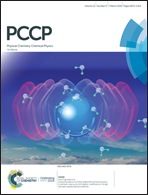The 3s Rydberg state as a doorway state in the ultrafast dynamics of 1,1-difluoroethylene†
Abstract
The deactivation dynamics of 1,1-difluoroethylene after light excitation is studied within the surface hopping formalism in the presence of 3s and 3p Rydberg states using multi-state second order perturbation theory (MS-CASPT2). Due to the proximity of the Rydberg π-3s state with the ππ* state, the states are mixed favoring ultrafast exchange of population via a conical intersection that closely resembles the equilibrium structure. After excitation, it is found that the π-3s state acts as a doorway state, trapping the population and delaying internal conversion to the ππ* state, from which deactivation to the closed-shell ground state takes place. Besides the conical intersection between the π-3s and ππ* states, five additional conical intersections between the ππ* state and the ground state are found, indicating that after the system is excited, it stretches the C![[double bond, length as m-dash]](https://www.rsc.org/images/entities/char_e001.gif) C bond before it twists and pyramidalizes at any of the carbon atoms, in the spirit of a hula-twist mechanism.
C bond before it twists and pyramidalizes at any of the carbon atoms, in the spirit of a hula-twist mechanism.

- This article is part of the themed collection: 2019 PCCP HOT Articles


 Please wait while we load your content...
Please wait while we load your content...